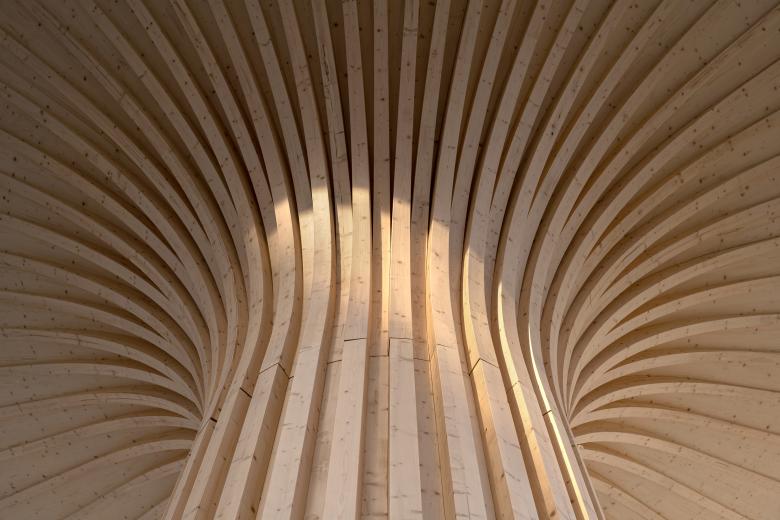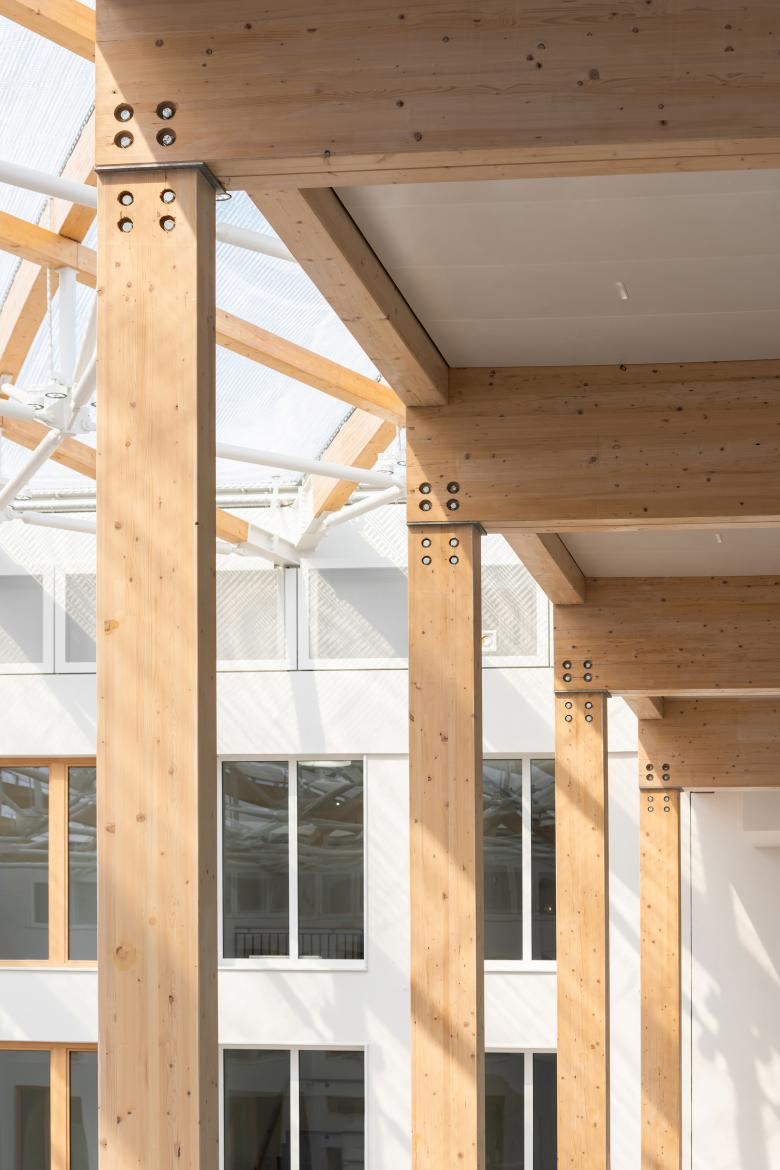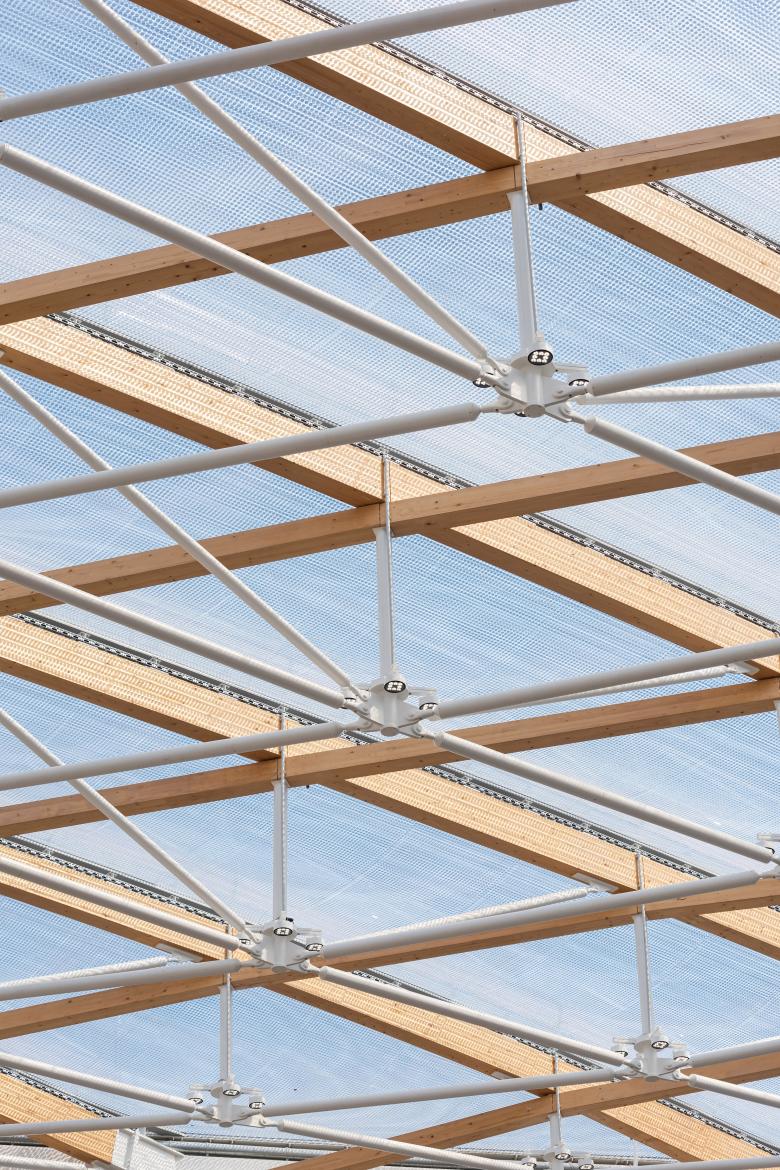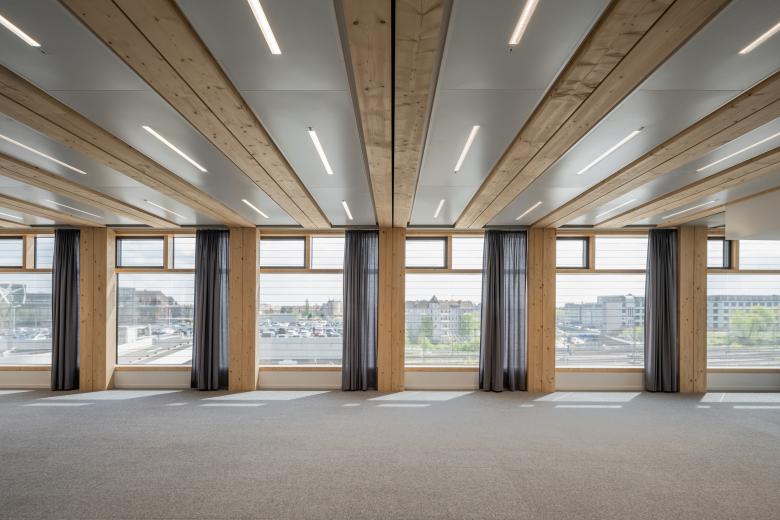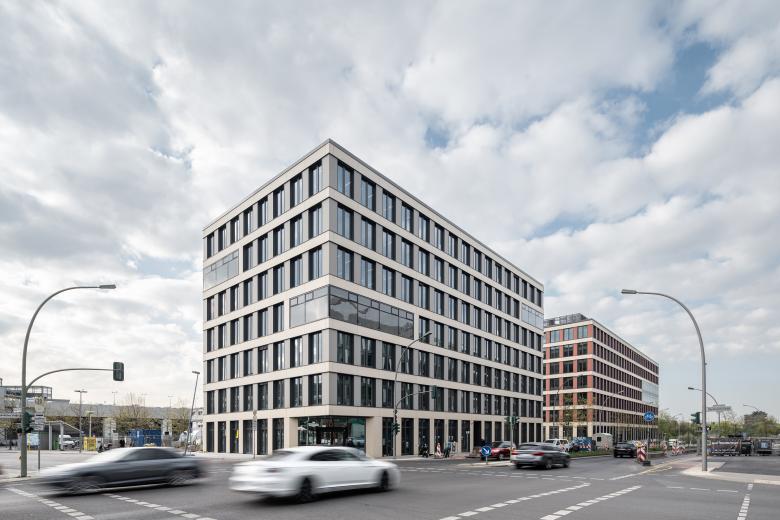The seven-storey office ensemble EDGE Suedkreuz Berlin was built entirely in sustainable modular timber hybrid construction. The larger of the two free-standing buildings covers around 20,000 m² of floor space, making it the largest free-standing wood-hybrid building in Germany - and one of the largest in Europe. From May 2022, it will serve as the new German headquarters for the energy supplier Vattenfall.
The smaller building is an elongated solitaire that follows the building line of the larger office building, which is designed as a Carré with an irregular trapezoidal ground plan. The two buildings form a flank to Hedwig-Dohm-Strasse and create a new, urban forecourt with green areas and seating towards Suedkreuz station.
At the heart of the Carré building is a spacious, light-flooded atrium, spanned by a transparent ETFE foil roof resting on a wooden truss construction. The central eye-catchers are the four tree-like structures, graduated in their heights, which carry the common platforms and are connected by filigree staircases. They lead up to the adjacent office floors via the platforms, thus forming an architectural communication network. On the fifth floor there is a sky lounge with panoramic windows.
Wood is visibly found in all interior areas of the building, enriching the clear architecture with a living element and thus bringing the aspect of nature into the individual rooms of the office complex, which is conceived as an open ecosystem. The forest as the origin of the formative material wood is thus also symbolically unmistakably at the centre of the architecture.
The façades are constructed in an even grid of sustainable and weather-resistant glass-fibre concrete panels. The sustainable façade elements weigh only 30 kg/m² and are recyclable. In addition, the façade absorbs CO2 from the air due to the thinly ground cement top layer and thus has a decarbonising effect.
In the construction of the buildings, the focus was on reducing the weight and thus the CO2 emissions as much as possible while combining the aesthetics of the building and the ethical treatment of nature. Through the intelligent combination of wood with concrete, the hybrid construction method can save up to 80 percent CO2 per m² of floor space. A low construction weight, shorter shell construction times, high planning and cost security and long durability are further advantages of this construction. The building materials used in EDGE Suedkreuz Berlin are largely recyclable according to the cradle-to-cradle principle.
Both the Solitaire and the Carré have a flexible modular floor plan grid on all levels, which can be adapted to individual wishes when converted. This allows modern, multifunctional working environments to be created: Open-space solutions promote communication and include retreat areas for intensive work phases as well as conference rooms and special zones such as lounges and team kitchens for informal exchange.
Both buildings of the office complex share an underground car park in the basement with 218 tenant-owned parking spaces geared towards e-mobility. Around 100 bicycle parking spaces, also for e-bikes, are located in the bicycle room and 32 more in the outdoor areas. Biomethane block-type thermal power stations ensure an efficient heat supply.
Supported by the wood-hybrid construction method, the project is pre-certified DGNB Platinum and receives Germany's first WELL Core & Shell Gold certificate.
EDGE Suedkreuz Berlin
Back to Projects list- Location
- Hildegard-Knef-Platz 2 und 3, 10829 Berlin, Germany
- Year
- 2022
- Client
- Colcap
- Team
- Julia Angelstorf, Lev Chestakov, Giorgia Fontana, Ulrike Graefenhain, René Hoch, Anastasia Kapustina, Valeria Kashirina, Birgit Koeder, Achim Linde, Fabiana Pedretti, Dennis Petricic, Manuela Peth, Soeren van Ost, Fabio Prada, Anja Schroth, Katharina Stranz, Carolin Trahorsch, Stephan Lohre, Karsten Waldschmidt
- General contractor
- ARGE SXB, Suedkreuz Berlin ZECH Bau GmbH, CREE Deutschland GmbH, Rhomberg Systemholzbau GmbH represented by ZECH Bau GmbH, Berlin
- Project management
- SMV Bauprojektsteuerung Ingenieurgesellschaft mbH, Berlin
- Landscaping
- hochC Landschaftsarchitektur, Berlin; granz + zecher architekten GmbH, Berlin
- Structural engineering
- Buro Happold GmbH, Berlin; BIT Buero fuer integrale Tragwerksplanung GmbH, Berlin
- Building technology
- Buro Happold GmbH, Berlin
- Sustainability consulting and DGNB/WELL certification
- Buro Happold GmbH, Berlin
- Interior design
- de Winder Architekten GmbH, Berlin
- Façades / glass-fibre concrete panels
- Rieder Group, Maishofen, Austria
- Façades / wall modules
- Opitz Holzbau GmbH & Co. KG, Neuruppin
- Hybrid ceilings
- BWE-Bau Fertigteilwerk GmbH, Lemwerder, thomas allton GmbH, Henningsdorf
- Solar-shading glazing
- MicroShade A/S, Glostrup, Denmark
- Roof construction Carré-Atrium metal
- Biedenkapp Stahlbau GmbH, Wangen
- Roof construction Carré-Atrium Wood / ETFE foil
- Temme // Obermeier GmbH, Rosenheim





